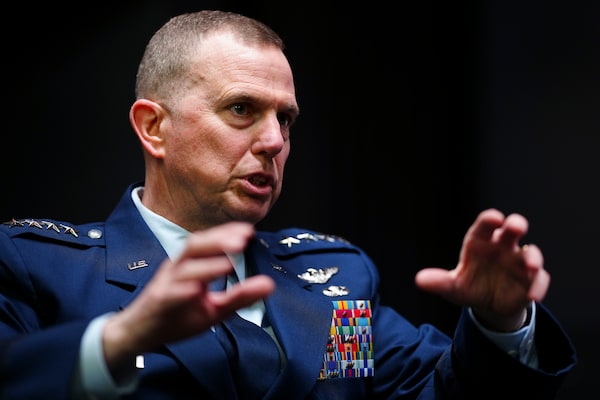
U.S. Air Force Gen. Gregory Guillot takes part in an interview with The Canadian Press, in Ottawa, on April 17.Sean Kilpatrick/The Canadian Press
American troops will be spending more time training in the Far North, the new commander of NORAD says, a strategy that fits “hand-in-glove” with Canada’s renewed focus on Arctic defence.
U.S. Gen. Gregory Guillot took over command of the binational North American Aerospace Defense Command in February.
His first order of business: a 90-day assessment of Norad’s capabilities, which includes visits to Canada.
During a stop in Ottawa in mid-April, Guillot outlined his plans to ensure NORAD is more mobile in the North and better equipped for the harsh climate.
“On the U.S. side, (there are) a lot of capable forces that have never been up there. So my goal is to bring them up for exercises,” he said in an interview.
Guillot said his discussion with Vice-Admiral Bob Auchterlonie, the commander of the Canadian Joint Operations Command, was “very enlightening” in getting an understanding of which parts of Canada’s vast North are accessible by road, water or air.
“The challenge in the Arctic, from my perspective, is to make sure that we have freedom of movement,” he said.
The Arctic is an area of particular concern for NORAD, which is tasked with defending North American airspace.
That came into clear focus in January 2023, when a high-altitude surveillance balloon from China was detected entering Alaskan airspace. Over the next several days, NORAD tracked the balloon as it passed over Canada and off the coast of South Carolina, where it was shot down by U.S. fighter jets.
The discovery of several more unidentified objects flying over North America in early 2023 led NORAD to reconfigure its detection systems as a stopgap measure while new radars are in the works.
Canada and the U.S. have committed to create a network of Arctic over-the-horizon radars. On the Canadian side the system is set to be up and running by 2028, with full capabilities in place by 2032.
That is part of a 20-year, $38.6-billion NORAD modernization program the Liberal government announced in 2022. The projects also include airfields and airstrips for a fleet of F-35 fighter jets.
Guillot said he’s keen to move those timelines up wherever possible. He also said NORAD is looking beyond the continent for help detecting threats over the Arctic.
“We are now reaching out to NATO and others to see if we can build a network to get that awareness earlier,” he said. That’s made easier, he added, by the increased co-operation that comes with Sweden and Finland joining the NATO alliance.
Guillot made headlines in Canada last July after an exchange he had with a Republican senator during his confirmation hearings.
Dan Sullivan raised the issue of Canada’s NATO spending, saying it is “not even close to pulling its weight,” and asking if Guillot would commit “to have those tough conversations” with Canadian officials once he assumed command. Guillot said he would.
But asked if he’s started with the tough talk, Guillot was quick to point out he was merely answering Sullivan’s question.
“I said ‘yes’ because I think with all of our partners, we’re all going to have tough conversations about resourcing and capabilities and priorities. And so I didn’t view that as singling towards Canada or any other country,” he said.
He praised the federal government’s planned increase in defence spending – which includes $8.1-billion in the next few years, and an additional $73-billion over 20 years – and said he’s “very encouraged” by the recently released defence policy update.
That document, called “Our North, Strong and Free,” makes clear that Arctic sovereignty is an urgent priority for the Armed Forces.
Among the promised upgrades: a new satellite ground station in the Arctic, operational support hubs that will allow for a year-round northern military presence, early warning aircraft and all-terrain vehicles that can function on ice and tundra.
As for whether Guillot thinks Canada is showing up with the level of seriousness needed on defence: “Absolutely, no question at all.”
Guillot expects to present Canadian and U.S. authorities with the results of his assessment next month.